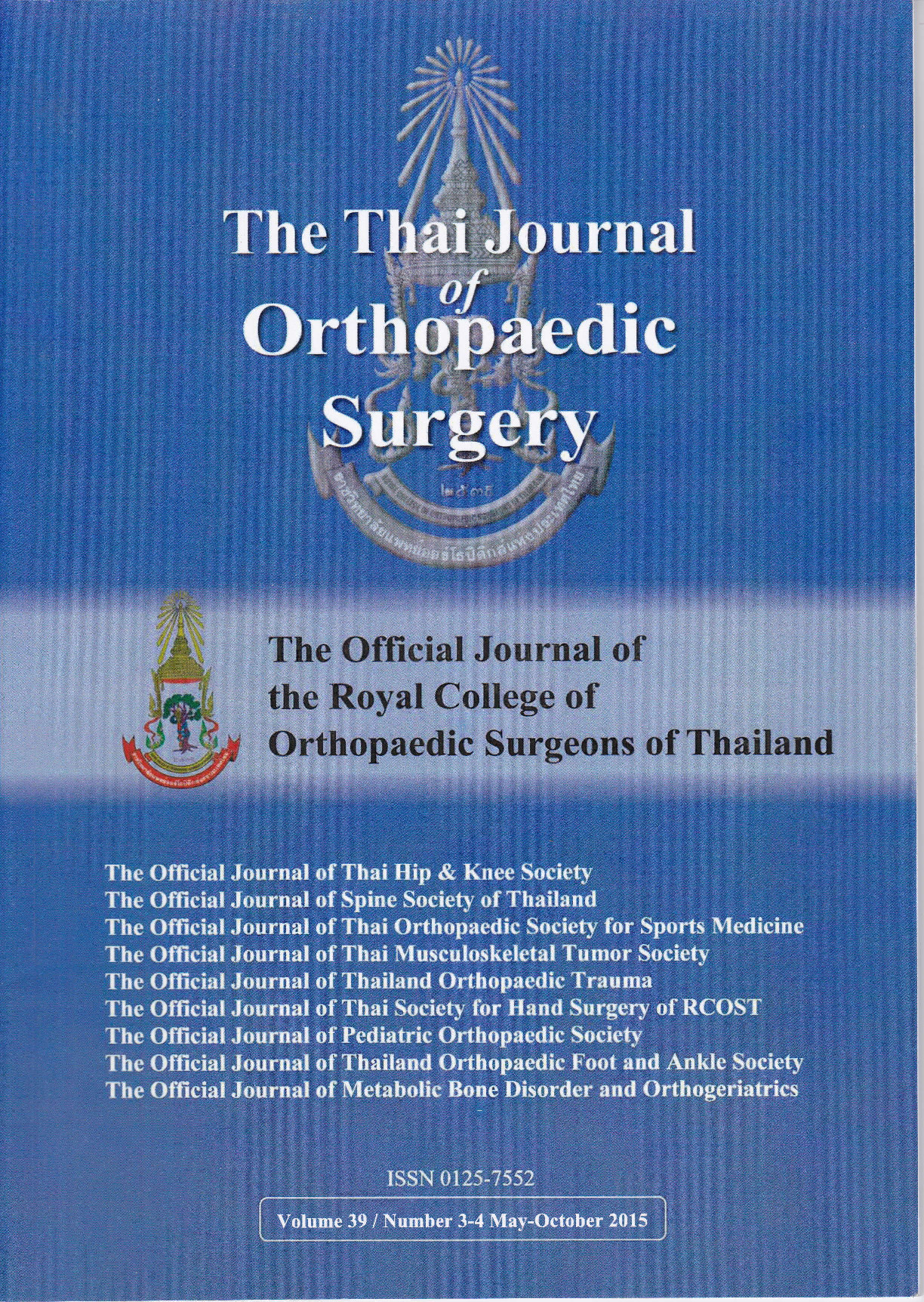การศึกษาเปรียบเทียบระหว่างการผ่าตัดเข้าด้านหลังและการผ่าตัดเข้าด้านนอกและด้านในในการรักษาผู้ป่วยที่มีกระดูกต้นแขนบริเวณข้อศอกหักในเด็ก
Main Article Content
บทคัดย่อ
วัตถุประสงค์: เพื่อศึกษาเปรียบเทียบผลการรักษาระหว่างการผ่าตัดเข้าด้านหลัง และ การผ่าตัดเข้าด้านนอกและด้านใน ในการรักษาผู้ป่วยที่มีกระดูกต้นแขนบริเวณข้อศอกหักในเด็ก วิธีการศึกษา: การศึกษาวิจัยแบบย้อนหลังโดยดูระยะเวลาในการผ่าตัด, การเสียเลือด, Baumann’s angle, Flynn’s criteria, และผลแทรกซ้อน
ผลการศึกษา: ผู้ป่วย 66 ราย แบ่งเป็น 2 กลุ่ม การผ่าตัดเข้าด้านหลัง 32 ราย และ การผ่าตัดเข้าด้านนอกและด้านใน 34 ราย ผลการรักษาพบว่าไม่ความแตกต่างกันในเรื่องของการเสียเลือด, Baumann’s angle, Flynn’s criteria และผลแทรกซ้อน แต่กลุ่มการผ่าตัดเข้าด้านหลัง ใช้ระยะเวลาในการผ่าตัดน้อยกว่าอย่างมีนัยสาคัญ (P< 0.05)
สรุป: การผ่าตัดเข้าด้านหลังมีคุณภาพเท่ากับการผ่าตัดเข้าด้านนอกและด้านใน ในการรักษาผู้ป่วยที่มีกระดูกต้นแขนบริเวณข้อศอกหักในเด็ก โดยใช้ระยะเวลาในการผ่าตัดน้อยกว่า
Article Details
เอกสารอ้างอิง
2. Aktekin CN, Toprak A, Ozturk AM, Altay M, Ozkurt B, Tabak AY. Open reduction via posterior triceps sparing approach in comparison with closed treatment of posteromedial displaced Gartland type III supracondylar humerus fractures. J Pediatr Orthop B. 2008;17:171–178.
3. Omid R, Choi PD, Skaggs DL. Supracondylar humeral fractures in children. J Bone Joint Surg Am.2008;90:1121–1132.
4. Farnsworth CL, Silva PD, Mubarak SJ. Etiology of supracondylar humerus fractures. J Pediatr Orthop.1998;18:38–42.
5. Gartland JJ. Management of supracondylar fractures of the humerus in children. Surg Gynecol Obstet.1959;109:145–154.
6. Oh CW, Park BC, Kim PT, Park IH, Kyung HS, Ihn JC. Completely displaced supracondylar humerus fractures in children: results of open reduction versus closed reduction. J Orthop Sci. 2003;8:137–141.
7. Reitman RD, Waters P, Millis M. Open reduction and internal fixation for supracondylar humerus fractures in children. J Pediatr Orthop. 2001;21:157–161.
8. Pirone AM, Graham HK, Krajbich JI. Management of displaced extension-type supracondylar fractures of the humerus in children. J Bone Joint Surg Am. 1988;70:641–650.
9. Ay S, Akinci M, Kamiloglu S, Ercetin O. Open reduction of displaced pediatric supracondylar humeral fractures through the anterior cubital approach. J Pediatr Orthop. 2005;25:149–153.
10. Bamrungthin N Comparison of posterior and lateral surgical approach in management of type III supracondylar fractures of the humerus among the children. J Med Assoc Thai. 2008 ;91:502-506.
11. Sangkomkamhang T, Singjam U, Leeprakobboon D. Risk factors for loss of fixation in pediatric supracondylar humeral fractures.J Med Assoc Thai. 2014 ;97 Suppl 9:S23-S28.
12. Paradis G, Lavallee P, Gagnon N, Lemire L. Supracondylar fractures of the humerus in children. Technique and results of crossed percutaneous K-wire fixation. Clin Orthop Relat Res. 1993;297:231–237.
13. Mazda K, Boggione C, Fitoussi F, Penneçot GF. Systematic pinning of displaced extension-type supracondylar fractures of the humerus in children. A prospective study of 116 consecutive patients. J Bone Joint Surg Br.2001;83:888–893.
14. Archibeck MJ, Scott SM, Peters CL. Brachialis muscle entrapment in displaced supracondylar humerus fractures: a technique of closed reduction and report of initial results. J Pediatr Orthop. 1997;17:298–302.
15. Kekomäki M, Luoma R, Rikalainen H, Vilkki P. Operative reduction and fixation of a difficult supracondylar extension fracture of the humerus. J Pediatr Orthop. 1984;4:13–15.
16. Yildirim AO, Unal VS, Oken OF, Gulcek M, Ozsular M, Ucaner A. Timing of surgical treatment for type III supracondylar humerus fractures in pediatric patients. J Child Orthop. 2009;3:265–269.
17. Kazimoglu C, Cetin M, Sener M, Aguş H, Kalanderer O. Operative management of type III extension supracondylar fractures in children. Int Orthop. 2009;33:1089–1094.
18. Sibly TF, Briggs PJ, Gibson MJ. Supracondylar fractures of the humerus in childhood: range of movement following the posterior approach to open reduction. Injury. 1991;22:456–458.
19. Labelle H, Bunnell WP, Duhaime M, Poitras B. Cubitus varus deformity following supracondylar fractures of the humerus in children. J Pediatr Orthop. 1982;2:539–546.
20. Skaggs DL, Cluck MW, Mostofi A, Flynn JM, Kay RM. Lateral-entry pin fixation in the management of supracondylar fractures in children. J Bone Joint Surg Am. 2004;86:702–707.


